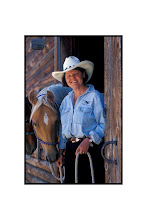Not surprisingly, many narratives, books, poems, and ballads have been written about brands. One such poem called "Ride for the Brand" written by Paul Harwitz is included here for your enjoyment.
Ride for the Brand
The dismounted young cowboy asked the old hand,
"What does it mean when they say 'Ride for the brand'?"
The grizzled old-timer's age seemed to drop years,
And he sat straight up in the saddle as he surveyed the steers.
"It means a lot of different things, son.
It has a lot to do with what's lost and what's won.
I ain't talking about gambling, but earning a living,
Hard work, trust, respect, taking, and giving.
"It means you don't never foul up the land,
And you don't take unfair advantage or rob.
You work hard, even when the work's rough as a cob.
That's part of what it means to ride for the brand.
"It means you help your neighbors and your friends,
And you help even strangers just passing through.
It means you hire on a hungry saddle-tramp
Who needs a place to winter past the cold and damp.
"It means you don't let the poor folks go hungry
Just 'cause they're down and short on grub and luck.
And it means that you don't work just for a buck,
But 'cause you need work like water's needed by a tree.
"It means you can be trusted, and that you trust each pard,
To do the chores that are needed, no matter how hard,
'Cause you're all riding for the same outfit,
And you're all striving together to benefit it.
"It means you keep searching for that one last stray,
Even though it's the end of the day,
Even though you'd rather stop and go to town.
It means you don't lay your responsibility down."
"It means you give an honest day's work for an honest day's wage,
Whether you're in the corral or out riding the range.
Every job's important, and there ain't none that ain't.
It's not the cowboy way to quit though it'd be easier to say 'I cain't.'
"It means you'll not complain when you help dig a well,
Nor even have to be asked to spell a tired cowpoke who's stove-up.
It means you'll work with others as well as you'll work alone,
And that even when you're tired to the bone, you'll cowboy-up.
"That's what it means, that, and a whole lot more.
It means that you've got pride in yourself, your job, and the land.
So saddle-up. Toughen-up. Cowboy-up. Be a man.
Ride for the brand."
Note: The following is an excerpt from Rangelands Magazine’s article titled “Branded Customer Service.” written by Les, Nunn, Assistant Operations Manager of the Padlock Ranch.
Ranch brands hold a rich and vibrant place in American history, as well as a unique position in today's ranching industry. Commencing in the late 18th century, cattle brands were in many ways some of the first trademarks used in commerce. These brands were a mark of ownership, termed the ironclad signature, distinguishing one rancher's livestock from another.
It was the livestock industry that implemented the use of brands. Many brands were simple; others were more descriptive and complex. Today brands are used by nearly every industry and play the same key roll as ever; that is to distinguish one company's product from another and to tell a story about the product.
The Padlock brand was purchased by Homer Scott shortly after he started putting the ranch together during the 1940's. This brand is the ranch's trademark and represents pride, duty, and stewardship while inspiring loyalty, dedication, and cowboy camaraderie.
Brands take on an entire legacy and contain the underlying story about the ranch they represent. As a result, the saying "riding for the brand" has a deep meaning to cattlemen and cowboys. Riding for the brand signifies a way of life and a depth of character to which people in the ranching business aspire.
Over the years, The Padlock brand has taken on a legacy of its own; one in which many have been and are still proud to ride for….. Reminiscing over the days gone by and looking forward to carrying the Padlock legacy forward and passing it on to future generations.


